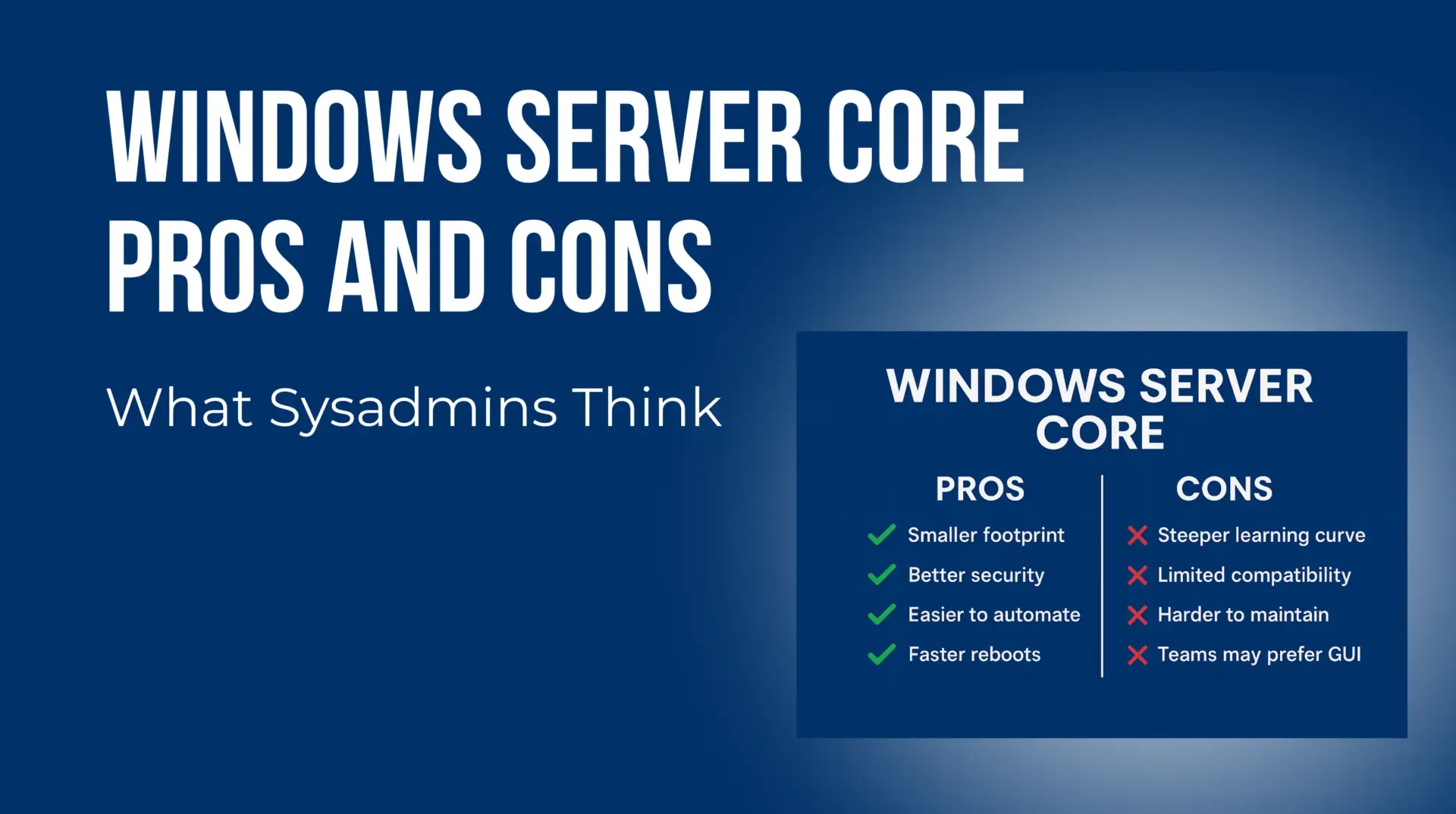By Edy Werder — IT Consultant & Tech Blogger
If you’re evaluating Windows Server Core, understanding the real-world pros and cons is essential. That’s why I asked 393 sysadmins on Reddit to share their experience.

In this article, I break down the most common Windows Server Core pros and cons—from security and automation benefits to vendor support issues and team readiness. Whether you’re considering Core for domain controllers, Hyper-V, or just trying to reduce overhead, this community-driven insight will help you make a smarter decision.
Recently, I asked the sysadmin community on Reddit a simple question:

To my surprise, the response was overwhelming—393 answers and over 130 upvotes.
Clearly, there’s still a lot of interest (and debate) around Windows Server Core in 2025. In this post, I’m breaking down what sysadmins had to say: when they use it, when they avoid it, how they manage it, and what tools they rely on.
This post supplements my practical guide on Windows Server Core: The Ultimate Guide to Microsoft’s Minimal Server Installation, but here, we’re taking a look at the real-world opinions from the field.
Do Sysadmins Still Use Server Core?
To find out how Windows Server Core is used in the real world, I ran a Reddit post asking sysadmins whether they still install Windows Server without the GUI. The response was overwhelming — nearly 400 answers in just a few days. See Reddit post asking sysadmins
Here’s the breakdown:
| Category | Count |
|---|---|
| Uses Server Core | 32 |
| Prefers GUI | 17 |
| Mixed Approach | 4 |
| Unclear or Neutral | 144 |
| Total Comments | 197 analyzed |
A decent number still install Server Core by default for specific roles—especially those integrated tightly with Microsoft services. Others prefer the GUI for vendor compatibility or team comfort.
When Server Core Makes Sense
One of the most frequent justifications for using Server Core was reduced attack surface, fewer updates, and less overhead.
The most common roles mentioned:
| Role | Mentions |
|---|---|
| Domain Controller | 38 |
| DHCP/DNS Server | 14 |
| File Server | 9 |
| Hyper-V Host | 8 |
| Web Server (IIS) | 6 |
| Cluster Node | 4 |
| License Server | 1 |
| Print Server | 0 |
“Yup, all DCs are Server Core. 0 issues. P’shell it up or WAC it off. Plenty of ways to get work done.”
“I only use Windows Server Core since more than a decade for everything. Sadly there are instances where Server Core is not supported.”
Looking for a compact server to run Windows Server Core in your homelab?
Tools That Make Core Usable
Managing a headless system might sound intimidating—but today’s tools make it surprisingly smooth:
| Tool | Mentions |
|---|---|
| PowerShell | 32 |
| RSAT (Remote Tools) | 20 |
| Windows Admin Center | 16 |
| RDP / Remote Desktop | 6 |
| MMC Snap-ins | 4 |
| Sconfig | 2 |
| Group Policy | 2 |
“PowerShell does 99% of what I need. The other 1%? Admin Center fills that gap.”
I prefer it for DCs, DHCP, File/DFS. But not everyone on my team is comfortable with PowerShell… so, Desktop Experience it is.”
Windows Server Core Pros and Cons
Here’s how the Pros and Cons stack up based on what sysadmins actually said:
| Pros | Cons |
|---|---|
| ✅ Smaller footprint, fewer updates required | ❌ Steeper learning curve for CLI-based management |
| ✅ Reduced attack surface = better security | ❌ Not all third-party tools/apps support Server Core |
| ✅ Ideal for infrastructure roles (DC, DNS, DHCP, Hyper-V) | ❌ Certain features (e.g. file indexing) require Desktop Experience |
| ✅ Easier to automate and script via PowerShell | ❌ Harder to maintain for junior admins or teams unfamiliar with CLI |
| ✅ Faster reboots, fewer GUI-related crashes | ❌ Teams may prefer GUI for speed, familiarity, or on-call handovers |
“If you need a GUI to install software, maybe rethink the process. Core is meant to be lean and remote-managed.”
“GUI isn’t the enemy—misconfiguration is. But sometimes you just need that checkbox you can’t script.”
“Too many junior admins are lost without a GUI. […] In reality, Windows admins tend to not be well versed in command line only management.”
“I’ve learned some tricks to make [PowerShell] more intuitive and easier to teach to junior techs.”
A lightweight OS deserves a fast SSD — here are some that work well for Server Core.
Voices from the Field – What Real Sysadmins Say
“We have a grand total of 0 Server Core installs.”
“WAC? It looks like someone botched a Google Summer of Code project. You always end up in PowerShell anyway.”
“I view not installing the GUI like some weird neckbeard sysadmin flex.”
“Using Server Core for DCs, CA servers, DHCP, File Servers, Azure AD Agents. Managing with RSAT and PowerShell.”
“Nope. I install it with GUI and only remove Desktop Experience if resources are tight. Usually I don’t bother.”
“This is one of those things that sounds good in principle, but in reality I’ve found that:
– Everyone in the admin team needs to be comfortable with PowerShell or the command line. If even one person isn’t, Server Core starts to lose value.
– In a DR or troubleshooting scenario, you don’t want to be thinking ‘WTF is the command for X.’ You want to fix things quickly — and sometimes the GUI makes that easier.
– The resource savings are OK, but not significant enough to outweigh the downsides.That’s why I usually recommend Desktop Experience. I’m happy to work with Core, but in most cases, it creates more hassle than it saves.”
These are just a few of the dozens of perspectives from professionals managing real-world systems.
My Take – Where I Use Core (and Where I Don’t)
Personally, I deploy Windows Server Core in environments where:
- I want minimal patching and lower surface area (like DCs and DNS)
- The workload is stable and CLI-friendly
- I can manage it via PowerShell, RSAT, or WAC
But for roles that require:
- Third-party software
- Heavy GUI interaction
- Or where others in the team aren’t comfortable with the command line
…I don’t hesitate to use Desktop Experience.
Conclusion
Server Core isn’t going away—it’s a powerful option for anyone who values performance, security, and automation. But it’s not for everyone.
The takeaway? Know your tools, understand your team, and choose the right version for the right role.
I’d love to hear from you — was this article helpful? Share your thoughts in the comments below. If you prefer, you can also reach me by email or connect with me on Reddit at Navigatetech.
IT Consultant & Blogger
Hi, I’m Edy Werder. I’m an IT consultant and the publisher of Edy’s Tech Blog. With 30+ years in the industry, I write hands-on guides about homelabs, Proxmox, NAS, and WordPress—tested in my own lab before I hit publish. If this article helped, consider supporting the site or sharing it with a friend.
Enjoying the content?
No sponsors, no fluff—just real configs and results.





